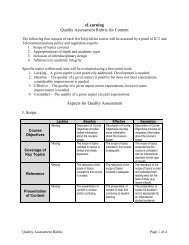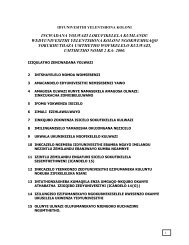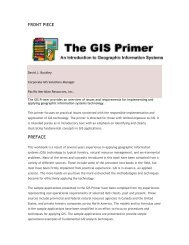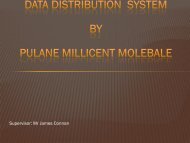Ecosystem Guidelines for Environmental Assessment
Ecosystem Guidelines for Environmental Assessment
Ecosystem Guidelines for Environmental Assessment
You also want an ePaper? Increase the reach of your titles
YUMPU automatically turns print PDFs into web optimized ePapers that Google loves.
SCEPS<br />
Look <strong>for</strong> obvious landscape features that may serve as ecological corridors or vegetation boundaries<br />
(e.g. watercourses, ridges or juxtaposed soil types). Aim to accommodate such corridors or vegetation<br />
boundaries in development plans, and manage them soundly to ensure their persistence.<br />
Look <strong>for</strong> opportunities to:<br />
- secure topographical and habitat linkages both between and within different ecosystems, vegetation<br />
types and ecological communities;<br />
- accommodate these corridors and vegetation boundaries within a spatial plan or project proposal;<br />
- minimize fragmentation of natural habitat - in general, small isolated patches of natural habitat<br />
are much less able to support ecological functioning than larger areas of natural habitat that<br />
remain connected to each other.<br />
Refer to the relevant ecosystem guidelines and determine what the “drivers” of the systems are (e.g.<br />
floods, pollination, edaphic variation, sand movement, fire or animal disturbance). Ensure that these<br />
drivers are identified and addressed in the planning phase of developments.<br />
In the long term, effective conservation of spatial components of ecological processes would be<br />
enhanced by:<br />
Accurate mapping and delineation of ecological corridors and/or vegetation boundaries at a scale<br />
that is practical <strong>for</strong> land-use planning and decision-making;<br />
Setting targets <strong>for</strong> the conservation of habitat within spatial components of ecological processes<br />
that have been mapped;<br />
Explicit incorporation of mapped corridors and vegetation boundaries in Spatial Development<br />
Frameworks;<br />
Integrating biodiversity priorities, including spatial components of ecological processes, in LandCare<br />
Area Wide Planning; and, where appropriate,<br />
Assigning appropriate management status to ecological corridors and/or vegetation boundaries (e.g.<br />
through stewardship agreements or proclamation as Protected Environments).<br />
To this end, guidance is given on environmental assessment procedures <strong>for</strong> working in spatial components<br />
of ecological processes, and land-use guidelines <strong>for</strong> development within ecological corridors and<br />
vegetation boundaries.<br />
6<br />
<strong>Environmental</strong> assessment procedures <strong>for</strong> working in spatial components<br />
of ecological processes<br />
As a broad yardstick <strong>for</strong> ensuring an appropriate approach, and level of rigour, <strong>for</strong> environmental<br />
assessment in spatial components of ecological processes, it is suggested that:<br />
Further loss of habitat within mapped spatial components of ecological processes should be avoided.<br />
Where irreversible loss of habitat cannot be avoided or mitigated, off-sets should emphasised.<br />
Generally, think in terms of functional networks: where there are clear opportunities in the natural<br />
landscape <strong>for</strong> linking fragments of the same ecosystem, and/or linking different ecosystems (e.g.<br />
coastal renosterveld to mountain fynbos, or a river system to associated wetlands or lowland vegetation);<br />
these opportunities should be accommodated within a spatial plan or project proposal. Setting aside<br />
natural habitat on one site with no connection to other natural or semi-natural areas could have limited<br />
value to biodiversity conservation.<br />
Consult the relevant ecosystem guidelines <strong>for</strong> the pattern and functional requirements of specific<br />
SPATIAL COMPONENTS OF ECOLOGICAL PROCESSES : 85
















